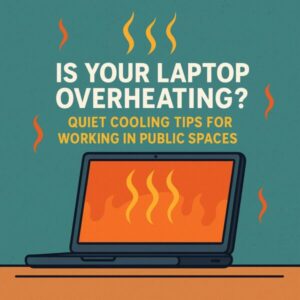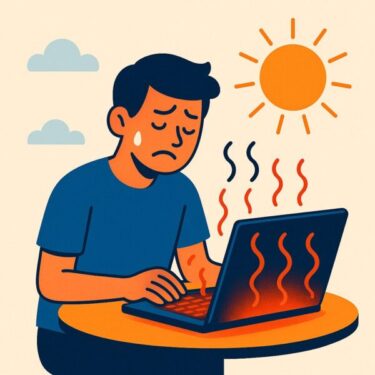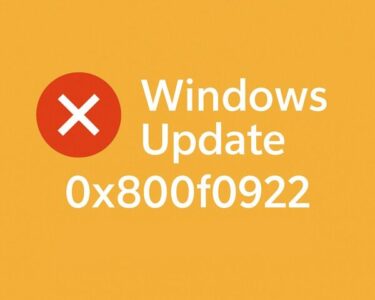
Working in cafés, libraries, or on the go is common in 2025—but an overheating laptop can make it difficult to concentrate. Loud fan noise, hot surfaces, and system slowdowns are common symptoms of thermal stress.
In this article, we’ll introduce effective and quiet ways to cool your laptop without disturbing those around you. These tips are ideal for remote workers, students, and frequent travelers.
- 1 Quiet Laptop Cooling Tips (No Fan Noise)
- 1.1 1. Place Your Laptop on a Flat, Hard Surface
- 1.2 2. Use a Passive Cooling Stand or Laptop Riser
- 1.3 3. Close Unnecessary Apps and Browser Tabs
- 1.4 4. Switch to Battery Saver or Balanced Power Mode
- 1.5 5. Use Fan Control Software (Optional)
- 1.6 6. Limit Maximum CPU Usage (Advanced)
- 1.7 7. Use Sleep or Hibernate When Idle
- 1.8 8. Avoid Charging While Performing Heavy Tasks
- 1.9 9. Avoid Sunlight or Hot Environments
- 1.10 10. Update Drivers and BIOS
- 1.11 11. Clean Vents and Monitor Temperature (Optional)
- 1.12 📊 Summary Table: Quiet Laptop Cooling Methods
- 2 Conclusion: Keep Your Laptop Cool and Quiet
Quiet Laptop Cooling Tips (No Fan Noise)
1. Place Your Laptop on a Flat, Hard Surface
Soft surfaces like blankets or tablecloths can block ventilation and trap heat. Use a wooden, plastic, or metal table where airflow isn’t obstructed, especially near the bottom and sides of your device.
2. Use a Passive Cooling Stand or Laptop Riser
Fans are not always practical in quiet environments. Passive cooling stands elevate your laptop to allow natural airflow underneath. Look for foldable, lightweight options that fit in a backpack.
3. Close Unnecessary Apps and Browser Tabs
Many apps run in the background and consume CPU power, especially browsers like Chrome or Edge. Closing unused tabs and background programs can significantly reduce heat generation.
4. Switch to Battery Saver or Balanced Power Mode
High-performance settings may cause unnecessary heat during light tasks. Use power-saving modes to lower CPU usage and extend battery life.
Windows: Settings → System → Power & Battery
5. Use Fan Control Software (Optional)
If the fan noise is too loud, consider using fan control software to adjust speed manually. Be cautious not to disable cooling entirely—monitor CPU temperature to stay within safe limits.
6. Limit Maximum CPU Usage (Advanced)
Reducing your processor’s maximum performance (e.g., to 80%) through Windows’ advanced power settings can lower heat output during prolonged tasks. This tweak is best for experienced users.
7. Use Sleep or Hibernate When Idle
Closing the lid doesn’t always stop background activity. Make use of Sleep or Hibernate modes when you step away to prevent unnecessary heat buildup.
8. Avoid Charging While Performing Heavy Tasks
Charging your laptop while running high-load apps can increase internal temperature significantly. If possible, charge during breaks or while the device is idle.
9. Avoid Sunlight or Hot Environments
Working near windows or outdoors can expose your laptop to direct sunlight and raise its surface temperature. Choose shaded or air-conditioned environments when available.
10. Update Drivers and BIOS
Thermal management often depends on up-to-date firmware. Manufacturers release patches that can optimize fan behavior and reduce heat. Visit your device manufacturer’s website for updates.
11. Clean Vents and Monitor Temperature (Optional)
Dust buildup inside vents can trap heat. Use compressed air or a small brush to clean the vents periodically. Also, consider monitoring your CPU temperature with free tools like HWMonitor or CoreTemp to ensure it stays in the safe range (below 85°C for most laptops).
[Affiliate Disclosure]
Recommended Quiet Cooling Accessories
- Foldable Passive Cooling Stand – Lightweight and easy to use in cafés
- Quiet Fan Laptop Cooling Pad – Actively cools while staying whisper-quiet
- Compressed Air & Cleaning Kit – Remove dust to improve heat dissipation
[Affiliate Disclosure] The links above are affiliate links. If you purchase through them, we may earn a small commission at no extra cost to you.
📊 Summary Table: Quiet Laptop Cooling Methods
| Tip | Why It Works |
|---|---|
| Flat hard surface | Improves ventilation |
| Passive cooling stand | Promotes airflow without noise |
| Close background apps | Reduces CPU load |
| Use power-saving mode | Prevents unnecessary heat |
| Limit CPU usage | Decreases thermal output |
| Sleep when idle | Avoids passive heat build-up |
| Avoid charging during load | Reduces combined heat |
| Stay out of sunlight | Prevents surface overheating |
| Update BIOS/drivers | Improves thermal control |
Conclusion: Keep Your Laptop Cool and Quiet
Overheating doesn’t always require active cooling solutions. Most of the time, reducing internal workload and improving ventilation is enough—especially in public or quiet places where fan noise is undesirable.
By combining multiple strategies listed above, you can keep your laptop cool and your environment peaceful—whether you’re working at a café, library, or airport lounge.
✔️You might also find these helpful:
▶︎How to Safely Clear the Windows Update Cache to Fix Update Issues (2025 Guide)
▶︎[Important] How to Extend Windows 10 Security Updates for Free Until October 2026
▶︎Why Is My Surface Battery Draining During Sleep? Real Causes and Fixes
▶︎How to Fix Sleep Mode Battery Drain on Windows 11 — Complete Step-by-Step Guide
▶︎Beginner’s Guide: How to Enable, Disable, and Fix a Laptop Touchpad (Windows 11/10)


